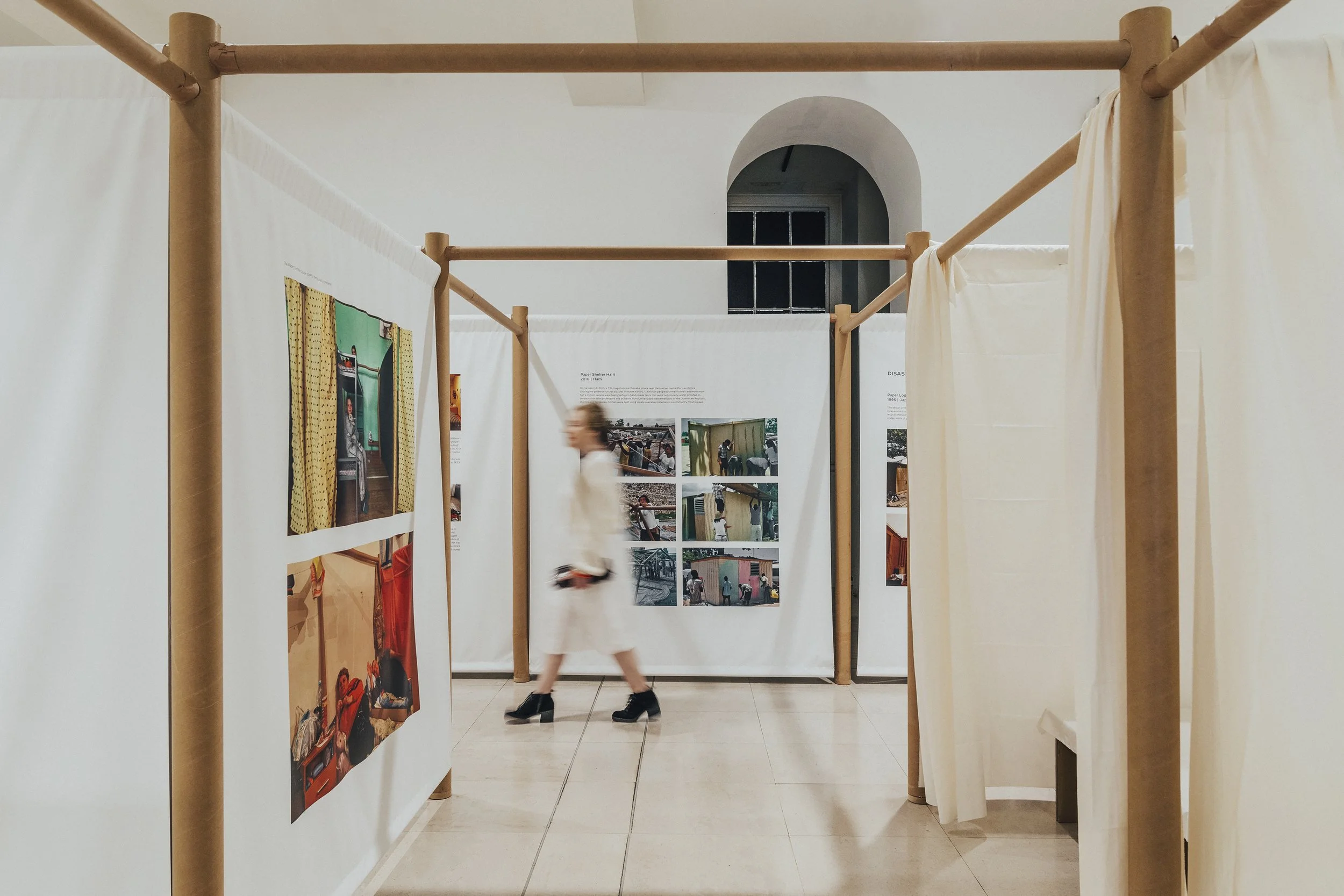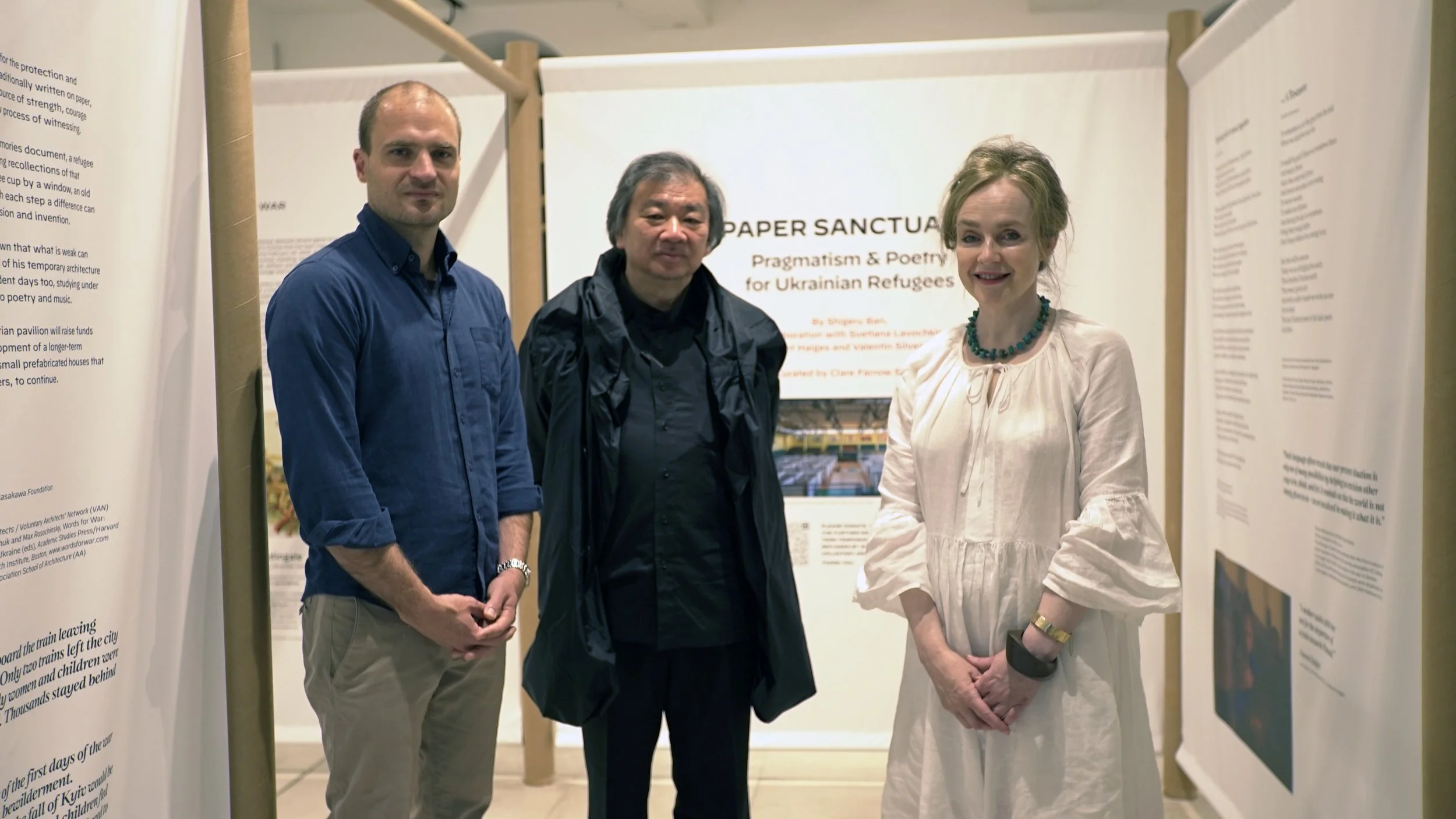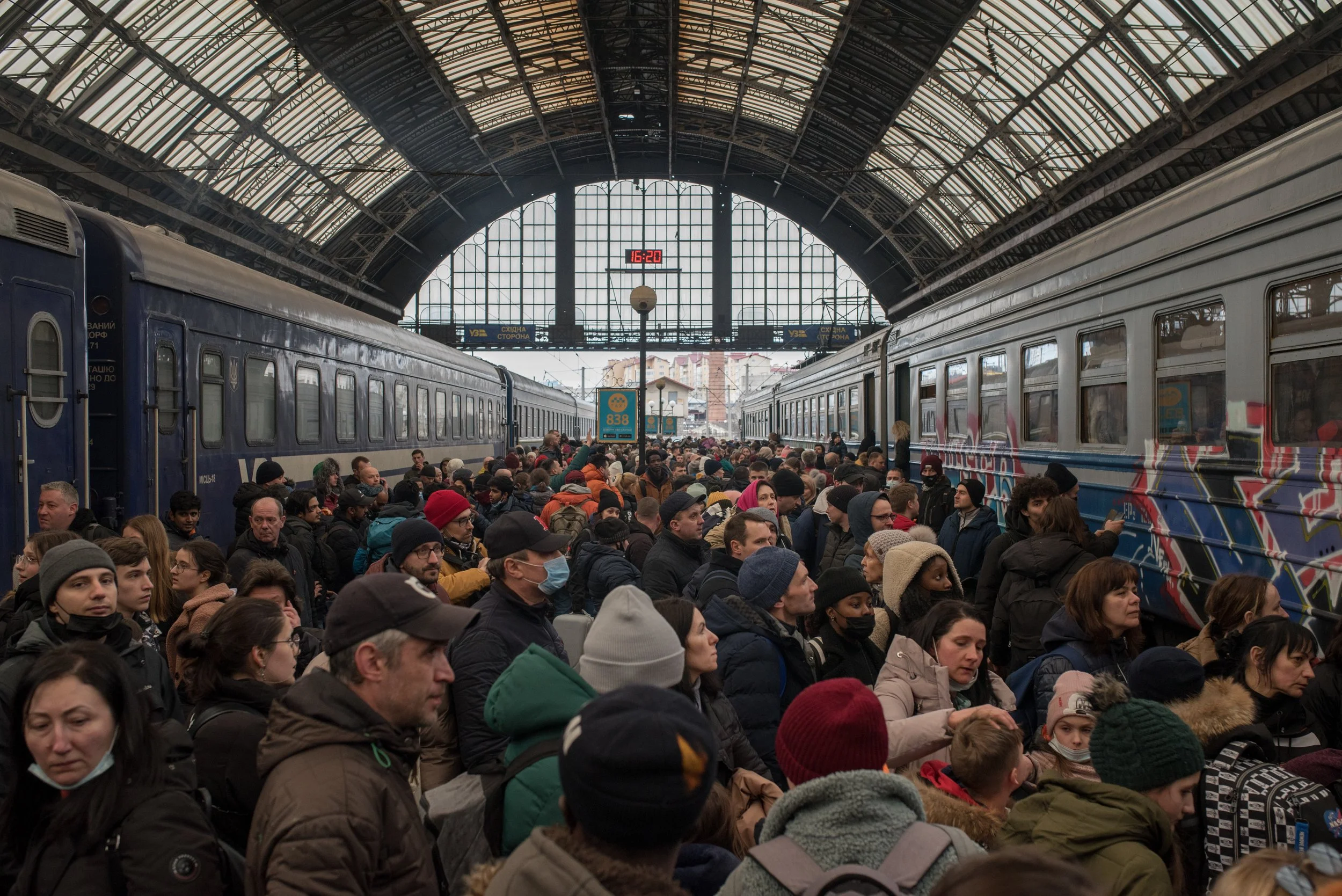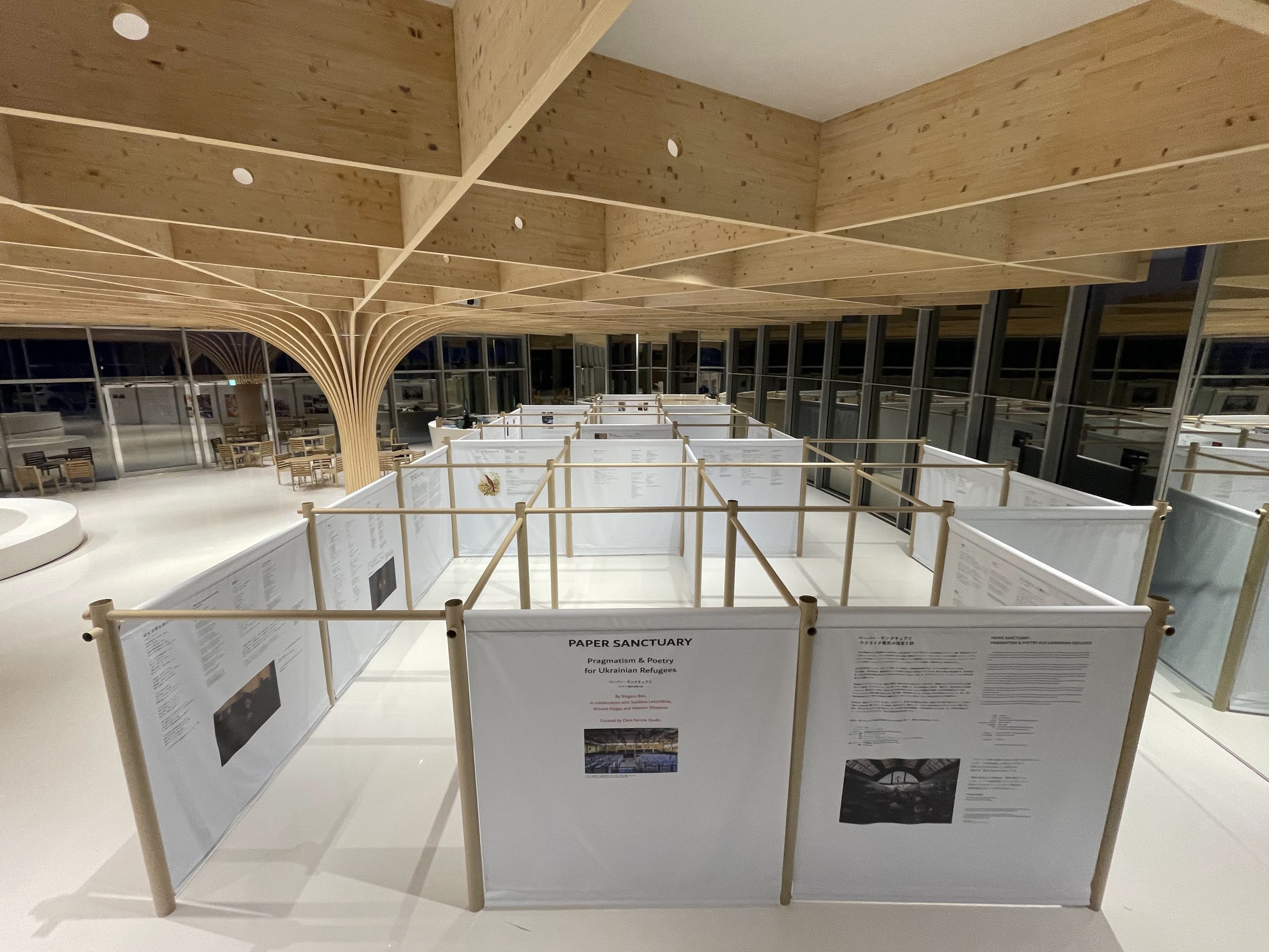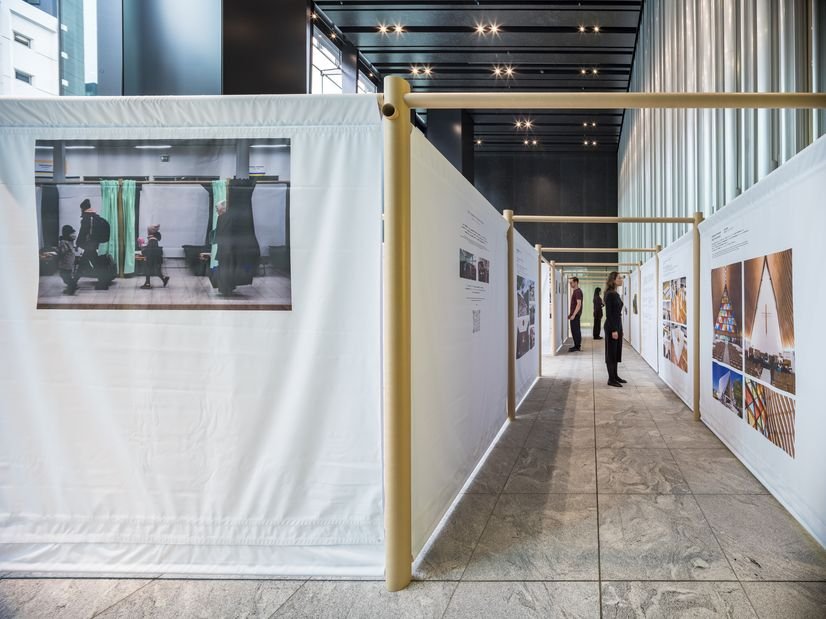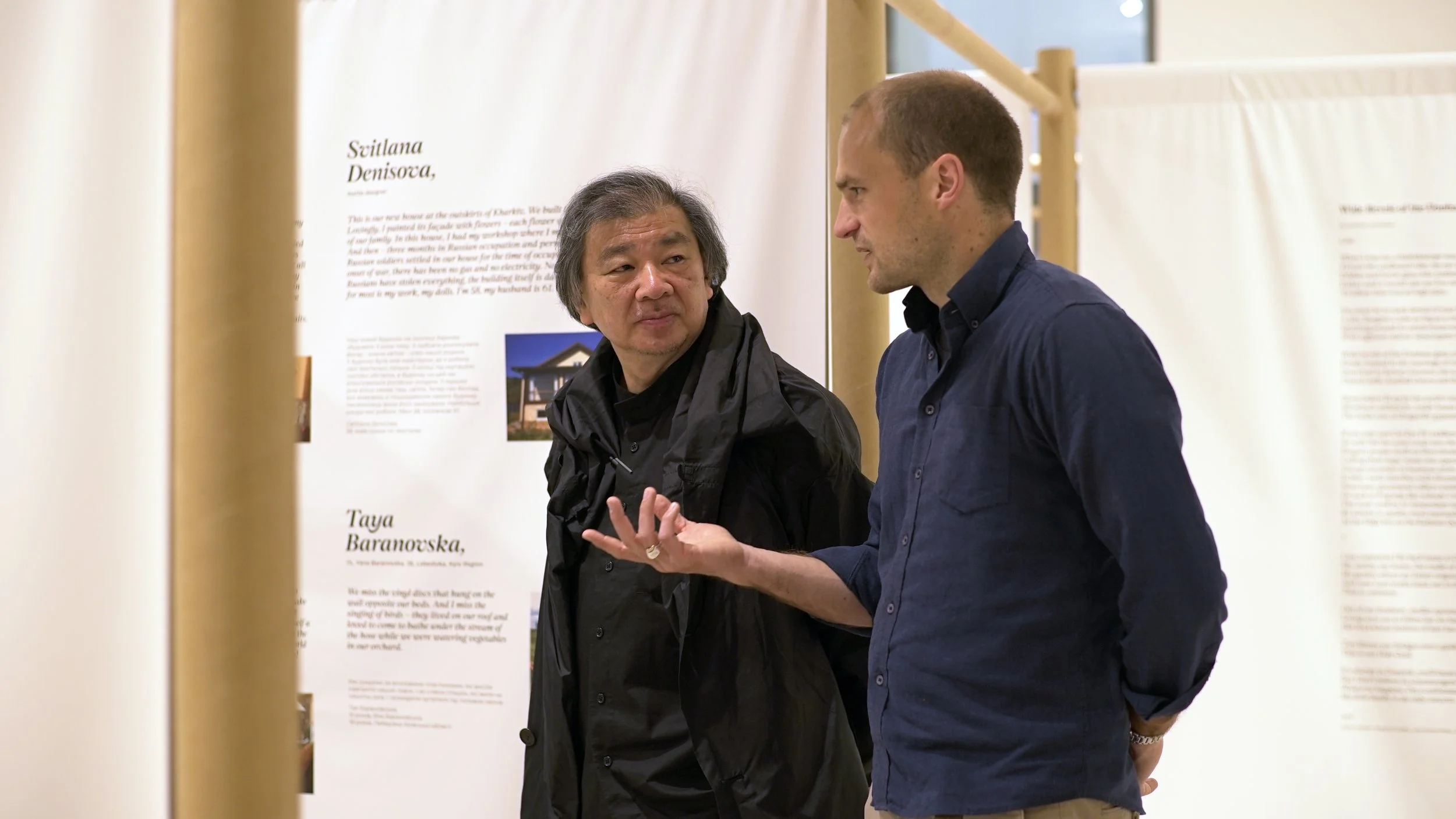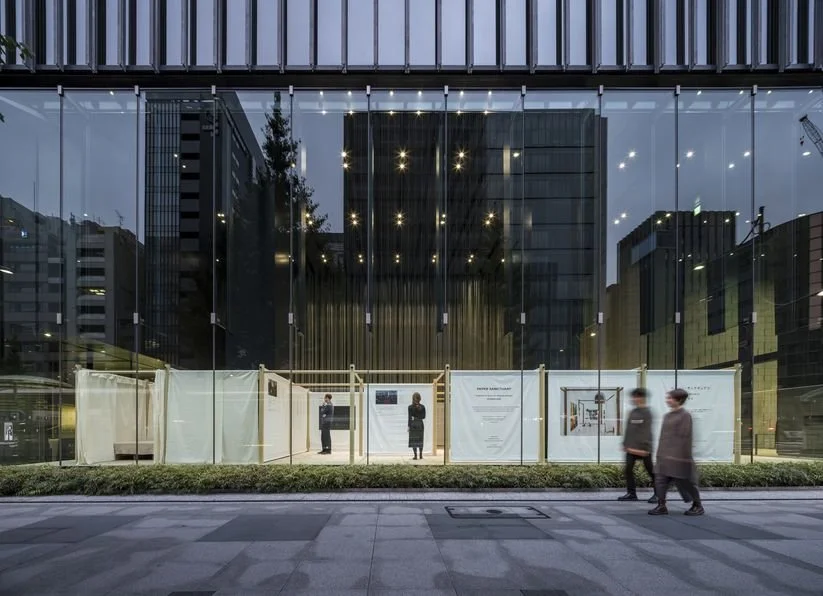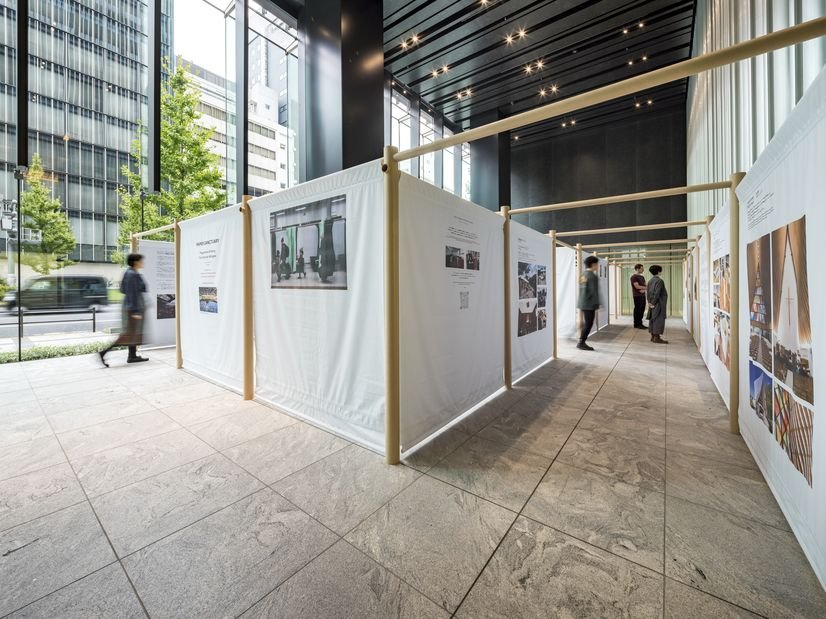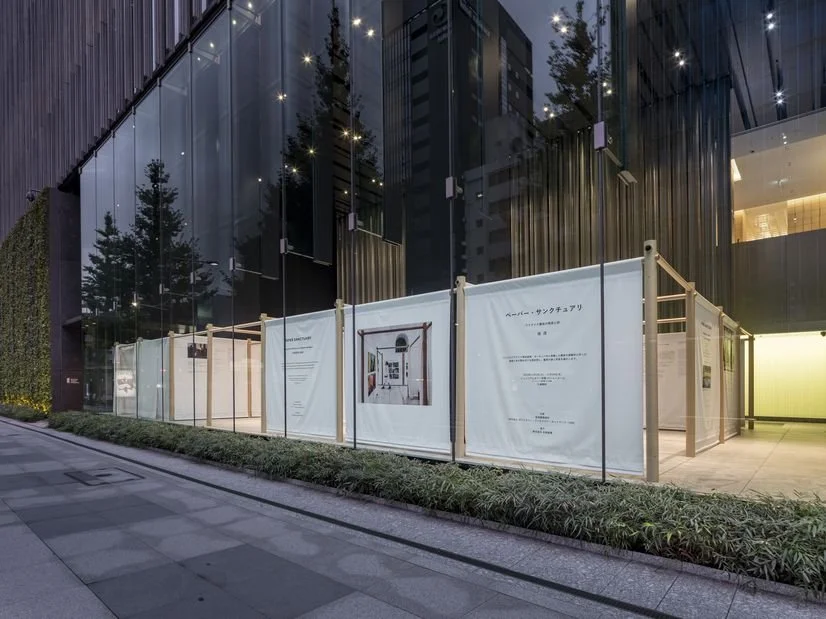Images: “Paper Sanctuary London”, 2023; Vincent Haiges, Shigeru Ban and Clare Farrow, June 2023, photo by Candida Richardson; Lviv Station, photo by Vincent Haiges, 26 February 2022
Paper Sanctuary: Pragmatism & Poetry for Ukrainian Refugees
By Shigeru Ban in collaboration with Svetlana Lavochkina, Vincent Haiges and Valentin Silvestrov, Curated by Clare Farrow Studio
Watch: “Paper Sanctuary” by Candida Richardson, with Shigeru Ban and Vincent Haiges, Music by Valentin Silvestrov, June 2023. Film © Candida Richardson & Clare Farrow Studio; Music © Valentin Silvestrov / ECM Records, courtesy of ECM Records. Film commissioned by Clare Farrow Studio with support from The Great Britain Sasakawa Foundation.
Presenting the Paper Partition System (PPS) by Japanese Pritzker Prize-winning architect and humanitarian Shigeru Ban, first invented for earthquake and other natural disaster situations, now used as temporary housing for war refugees.
Named the first Humanitarian Pavilion at London Design Biennale, and exhibited in The Great Arch Hall of Somerset House (1-25 June 2023), the immersive project reflects the work of Ban’s NGO, Voluntary Architects’ Network (VAN), in providing temporary housing for Ukrainian refugees. The cardboard-tube modular system transforms any large indoor space (e.g. a gymnasium) into a shelter for privacy, dignity and hope. The exhibition has now travelled from London and toured extensively in Japan:
“Paper Sanctuary”, Somerset House, London, 1 - 23 June 2023
“Paper Sanctuary Simose”, Simose Art Museum, Hiroshima, 28 August - 3 September 2023
“Paper Sanctuary Kobe”, Kobe City Hall, Kobe, 17 - 30 October 2023
“Paper Sanctuary Tokyo”, Museum Tower Kyobashi, 2 - 30 November 2023
“Paper Sanctuary OPAM”, Oita Prefectural Art Museum (OPAM), 13 January - 4 February 2024
“Paper Sanctuary Naoetsu”, MUJI Naoetsu (Joetsu city in Niigata), 13 - 29 February 2024
“Paper Sanctuary Toyota”, Toyota City Museum, 26 April - 26 May 2024
“Paper Sanctuary SIT”, Shibaura Institute of Technology (SIT), 20 September - 20 October 2024
Initiated through a conversation between Shigeru Ban and Clare Farrow, who first interviewed the architect in 2011 - writing a cover feature for Blueprint (‘A House of Card’) - “Paper Sanctuary” also marks a collaboration with Ukrainian-born poet, novelist and literary translator Svetlana Lavochkina, Berlin photographer Vincent Haiges, and Ukrainian composer Valentin Silvestrov.
With a collection of Ukrainian war poems, a short essay by Lavochkina called ‘The Nightingale’, photojournalism by Haiges, and refugees’ memories of home (sourced through an open call), printed on to the fabric of the paper partitions, examples of Ban’s disaster work are also exhibited alongside his design for a cardboard modular bed, which combines lightness with endurance. Silvestrov’s “Bagatelles” play continuously and movingly in the space, courtesy of ECM Records.
Printed Catalogue:
“Paper Sanctuary: Shigeru Ban”, 2024, 127 pp, Japanese & English
Short Films by Candida Richardson:
"Shigeru Ban: Paper Partition System (PPS)”, Interview by Clare Farrow, London, June 2023, © Candida Richardson & Clare Farrow Studio, 2025
“Shigeru Ban: Architecture and Poetry”, Interview by Clare Farrow, London, June 2023, © Candida Richardson & Clare Farrow Studio, 2025
“Shigeru Ban: Paper Sanctuary”, Interviews with Shigeru Ban and Vincent Haiges, Music by Valentin Silvestrov, June 2023, Film © Candida Richardson & Clare Farrow Studio; Music © Valentin Silvestrov / ECM Records, courtesy of ECM Records
Selected Press:
Dezeen, ‘Ten Standout pavilions from the 2023 London Design Biennale, 1 June 2023
Wallpaper*, ‘London Design Biennale 2023’, 19 June 2023
Tokyo Art Beat, “Paper Sanctuary: The Reality and Poetry of Ukrainian Refugees”
Text by Clare Farrow:
Ban’s Paper Partition System (PPS) is a simple yet powerful shelter, composed of humble materials: cloth curtains and paper tubes from the fabric industry that interlock to form reusable, sustainable modules. Easy to assemble, the nomadic system allows for rapid deployment across numerous sites, and since March 2022 Shigeru Ban and his NGO “VAN” (Voluntary Architects’ Network) have installed it in schools and gymnasiums in Ukraine, Poland, Slovakia and France.
A sanctuary in architectural terms is a physical shelter, a place that provides refuge and safety from danger, a place that many Ukrainians, mostly women, children and the elderly, have sought to find. Leaving their homes with very few belongings, they have been forced to escape, on trains, buses, on foot. More than 13 million people have been uprooted since the war began. This type of mass migration of displaced people has not been seen since WW2.
A sanctuary can also be a holy or sacred place, for the protection and comfort of the spirit. Both poetry and music, traditionally written on paper, can offer that refuge from the world too, as a source of strength, courage and fortitude. But before poetry comes the raw process of witnessing.
With each step, as many of the poems and memories document, a refugee moves further and further from home, treasuring recollections of that familiar place: a pear tree in the garden, a coffee cup by a window, an old chair, a much-loved pet. At the same time, with each step a difference can be made by others, through empathy, compassion and invention.
Using humble, “weak” materials, Ban has shown that what is weak can also be strong, “if it is loved”, and the survival of his temporary architecture is testament to this philosophy. Since his student days too, studying under John Hedjuk, he has compared architecture to poetry and music.
It is hoped that the Biennale’s first humanitarian pavilion will raise funds through public donation to further the development of a longer-term temporary housing system by Shigeru Ban: small prefabricated houses that will allow the lives of individuals, not numbers, to continue.
Architect:
Shigeru Ban
Curator:
Clare Farrow Studio
Production:
Shigeru Ban Architects / VAN
Poetry, Essay and Translation:
Svetlana Lavochkina
Photography:
Vincent Haiges
Music:
Valentin Silvestrov, Bagatellen und Serenaden, ECM Records
Installation:
Shigeru Ban Architects / VAN
Architectural Association students Asad Nasir Qureshi, Natalia Juca Freire, Vidhi Bhargava, Pinak Bhapkar, Selin Ozasik, Gautami Bhoite
Sound:
Matt Jarvis, Creative Technologist
Printing:
Omni Colour
Supporters:
Great Britain Sasakawa Foundation
Japan Foundation
ECM Records
Shigeru Ban Architects / Voluntary Architects’ Network (VAN)
Oksana Maksymchuk and Max Rosochinsky, Words for War: New Poems for Ukraine (eds), Academic Studies Press/Harvard Ukrainian Research Institute, Boston
Architectural Association School of Architecture (AA)
